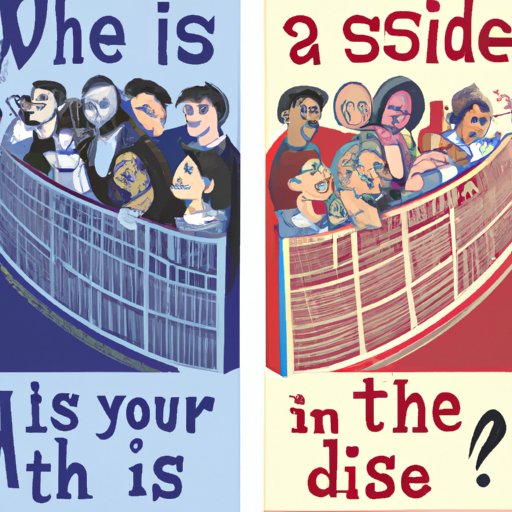Introduction
When it comes to issues of social justice, taking a side can be difficult. But for the Almanac Singers, a folk music group formed in the 1940s, the answer was clear: “Which side are you on?” This powerful question became the title of the group’s most iconic song, which has since become an anthem for labor rights and social justice movements around the world.
In this article, we will explore the story behind the song, its impact on the labor and social justice movements of the 1940s, and its continued relevance in today’s world.
As you read, consider your answer to the question posed in the song’s title: which side are you on?
The Story behind Almanac Singers’ “Which Side Are You On?”
The Almanac Singers were a folk music group formed in 1940 by Woody Guthrie, Pete Seeger, and several other musicians. Their music was inspired by the union organizing and labor rights movements of the time, and they performed at rallies, concerts, and other political events.
“Which Side Are You On?” was written in 1931 by Florence Reece, the wife of a union organizer in Kentucky. According to legend, Reece wrote the song while hiding under a bed during a raid by company thugs searching for her husband. The lyrics express Reece’s frustration with the violence and repression faced by workers and their families:
“Come all of you good workers, good news to you I’ll tell,
Of how that good old union has come in here to dwell.
Which side are you on, boys? Which side are you on?
They say in Harlan County, there are no neutrals there.
You’ll either be a union man or a thug for J. H. Blair.”
How Almanac Singers’ “Which Side Are You On?” Became an Anthem for Social Justice
As the Almanac Singers began to perform “Which Side Are You On?” at their concerts, the song quickly become a favorite among labor rights activists and workers. Its call for solidarity and opposition to oppression resonated with those fighting for better working conditions, fair wages, and the right to unionize.
But “Which Side Are You On?” soon took on a life beyond the labor movement. As American involvement in World War II became inevitable, the song became a symbol of opposition to fascism and war. Its message of unity and resistance appealed to those fighting against militarism and bigotry, both in America and abroad.
From civil rights to anti-war movements, “Which Side Are You On?” became a staple at protests and rallies for social justice causes. Its powerful message of solidarity and opposition to oppression continues to inspire activists around the world today.
Almanac Singers’ “Which Side Are You On?”: A Historical Analysis of Its Impact on Labor Rights Movements
But “Which Side Are You On?” was more than just a song at rallies. It played a critical role in labor rights campaigns and union organizing efforts throughout the 1940s.
The song helped to galvanize workers and labor activists, reminding them of the importance of solidarity and the need to resist oppression. Its popularity helped to raise awareness of labor rights issues and promote union organizing efforts.
Perhaps most significantly, “Which Side Are You On?” helped to shift the discourse around labor issues during the 1940s. The song forced politicians and the media to take notice of the problems faced by workers and their families, and it helped to mobilize public support for unionization and better working conditions.
The Political Significance of Almanac Singers’ “Which Side Are You On?” during the 1940s
At the time of its release, “Which Side Are You On?” was a controversial song. Some saw it as divisive and unpatriotic, a threat to American values and the war effort. Others saw it as a powerful statement of resistance and solidarity, emblematic of a new era of progressive politics.
But beyond the political and cultural climate of the 1940s, “Which Side Are You On?” contributed to larger debates around the role of music and art in politics and activism. It was a statement of the power of music to move people, to inspire them to action and change.
As historian Harvey Klehr noted, “Songwriters like Guthrie and Seeger treated their craft as no less than a duty to disseminate their political beliefs.” And “Which Side Are You On?” was no exception.
“Which Side Are You On?”: The Relevance of Almanac Singers’ Social Commentary in Today’s World
So what can we learn from “Which Side Are You On?” today?
For starters, we can see the power of music to inspire social change. Whether it’s a protest song from the 1940s or a modern-day hip-hop anthem, music has the ability to connect with people on a deep level and motivate them to take action.
Secondly, “Which Side Are You On?” reminds us of the importance of solidarity in the face of oppression. Whether we’re battling income inequality, unaffordable healthcare, or police violence, we must stand together and fight for a better world.
Finally, “Which Side Are You On?” serves as a call to action. We cannot simply sit back and watch as injustice persists in our communities and our world. We must get involved, speak out, and fight for what is right.
Conclusion
In conclusion, “Which Side Are You On?” is more than just a song. It’s a symbol of resistance, solidarity, and hope. It reminds us of the struggles faced by those fighting for labor rights and social justice, and it inspires us to continue the fight today.
So which side are you on?
It’s time to take a stand.
